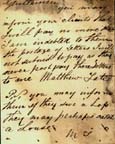These letters graciously have been shared with the Victorian Web by Eunice and Ron Shanahan; they have been taken from their website. The letters give an insight into the daily lives and concerns of ordinary people without whom history would not exist. The letters are a wonderful example of how much history may be gleaned from such primary sources.
There was no compulsion to pay postage until the 1850s, but the choice to pay or not was available right from the beginning of the postal systems. For those who were entitled not to pay and the conditions restricting the use see the Free Postage section.
 What about the payment of one penny to the postman on the street? In Frank Staff's book, The Penny Post, 1680-1918 he
includes an illustration
of 'A postman with a bell about 1820. The penny he received for taking
the letter to the General Post Office was his perquisite.' This was because it was not the usual practice, as there were so many Receiving
Houses, both for the General Post, and for the London Penny Post, that it was
easy enough to take your letter to the nearest one. He also quotes from The
Picture of London for 1805: "Houses or boxes for receiving letters before four o'clock at the West-end
of the town, and five o'clock in the City, are open in every part of the metropolis;
and after that hour bellmen collect the letters during another hour, receiving
a fee of one penny for each letter."
The bellman
disappeared from London streets from the 5 July 1846, following a announcement
by the Postmaster General that they were to be abolished. This illustration
is of a British postage stamp issued in 1979 to mark the centenary of the death
of Sir Rowland Hill.
What about the payment of one penny to the postman on the street? In Frank Staff's book, The Penny Post, 1680-1918 he
includes an illustration
of 'A postman with a bell about 1820. The penny he received for taking
the letter to the General Post Office was his perquisite.' This was because it was not the usual practice, as there were so many Receiving
Houses, both for the General Post, and for the London Penny Post, that it was
easy enough to take your letter to the nearest one. He also quotes from The
Picture of London for 1805: "Houses or boxes for receiving letters before four o'clock at the West-end
of the town, and five o'clock in the City, are open in every part of the metropolis;
and after that hour bellmen collect the letters during another hour, receiving
a fee of one penny for each letter."
The bellman
disappeared from London streets from the 5 July 1846, following a announcement
by the Postmaster General that they were to be abolished. This illustration
is of a British postage stamp issued in 1979 to mark the centenary of the death
of Sir Rowland Hill.
For examples of paid and unpaid letters to the same person, from the same person, see the letters of the Revd. T. Simpson Evans.
Generally the head of the family would pay the postage on letters, whether it was sending the servant to the post office to deliver the letters written, or to collect the incoming letters. In Jane Austen's books there are many references to the mail. The Bennet family is in a fever of anticipation waiting to hear from Mr. and Mrs Gardiner after Lydia has eloped, and that comes in from the post office.
In the other cases letters are delivered by servants, or slipped into the hands of the receiver. Vicar's daughters — as represented so beautifully by Jane Austen — would be unlikely to have money of their own so the father would have paid. It was generally accepted that the recipient paid the postage, therefore they would only write to someone they knew would be able to pay to receive it.
People likely to send paid letters :-
- Solicitors, who added the cost of postage to the bill — I have many such letters, listing the details of the accounts, in which Postage is quite a large amount.
- Commercial travellers would send it unpaid so head office would pay the incoming postage bills. I have a series of 40 letters from a commercial traveller in haberdashery from 1828-1832, written to his head office in London. The letters are posted from all over England as he drives out to make sales, and not one of these letters has been pre-paid.
However, some were less happy about paying postage; this example was written by Mr Matthew Tate from Hull in the north of England, in 1837, and he sounds very irate:

[Click on the thumbnail for a larger image.]
Gentlemen
you may inform your clients that I will pay no more than I am indebted to them, the postage of letters I will not submit to pay, as they never post pay there letters to me.
He then adds this cryptic postscript.
P.S. you may inform them if they save a Loss they may perhaps catch a Louse.
M.T.
16 April, 2007